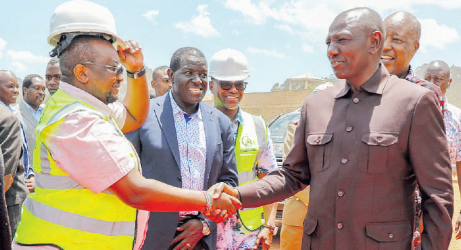
At least 124,000 units are currently being built under the affordable
housing programme, according to
the latest tally.
The Ministry of Lands, Public Works, Housing and Urban Development, which oversees the programme, said the units are spread in 40 counties.
“This effort has generated an impressive 206,000 jobs, giving a much-needed boost to the country’s economy. Further, the initiative has led to a 40 per cent increase in mortgage refinancing, making homeownership more attainable for many Kenyans,” the ministry said.
A housing unit refers to a room or group of rooms occupied as one living quarter, in a block of apartment. Government spokesman Isaac Mwaura said 64,211 units under the Affordable Housing Programme had been booked by September 5, with 539,623 Kenyans saving more than Sh2.2 billion.
The Affordable Housing programme is one of President William Ruto’s signature programmes under his bottom up manifesto. Kenyans pay 1.5 per cent of their gross income to fund the project.
It aims to bridge the housing deficit caused by increased urbanisation and low affordability for housing units. Nearly three in every 10 Kenyans live in cities, and the urban population is growing at a rate of 4.2 per cent every year.
With this level of growth, Kenya requires approximately 200,000 new housing units annually to meet demand, yet only 50,000 homes are built, leaving the housing deficit growing by 150,000 units per year.
“As a result of this mismatched supply and demand, housing prices have increased by 100 per cent since 2004,” the ministry said.
Mwaura said the programme will soon expand to all 290 constituencies. The housing units are categorised into four.
The first category, the social housing unit, is designed for a person whose monthly income is below Sh20,000. One room will be sold at Sh840,000, two rooms Sh1.26 million and three rooms Sh1.68 million, payable in monthly instalments for up to 30 years.
The second category targets Kenyans earning between Sh20,000 and Sh100,000 every month.
They are eligible for studio house at Sh960,000, two bedroom at Sh1.92 million and three bedroom Sh2.88 million.
The middle class housing unit targets people earning more than Sh100,000. Their units, which come in different sizes, will be sold for Sh4.32 million and Sh5.76 million for two-bedroom and three-bedroom respectively.
The costs are payable in monthly instalments over 30 years, at an interest rate of nine per cent. According to the programme, the last category is the rural affordable housing unit.
The houses will be selling at for Sh910,000 for one room, Sh1.56 million for two rooms and Sh1.95 million for three rooms.
Mwaura said the programme is not just about constructing houses but building a sustainable ecosystem that will support long-term urban development.
For instance, 213 artisans have received on-site recognition from the National Environment Training Institute for their prior learning assessments, helping them to gain official certifications that will enhance their employability and contribute to the broader goal of economic recovery.
“This programme not only provides housing but also dignifies our youth and stimulates the economy,” Mwaura said.
The ministry also said the programme leans on technological advancements to improve efficiency. Land services in Nairobi and Murang’a have also been digitised and the public can now access them via the Ardhisasa platform.
This step forward ensures a smoother, more transparent process for land transactions, which is essential in the housing development space.
The programme is focused on settling landless households, with nearly 20,000 families resettled over the past two fiscal years, mainly in coastal regions such as Mombasa, Kwale and Lamu as well as in inland counties such as Nakuru, Makueni and Nandi.
In the 2024 - 25 fiscal year, the government intends to construct 66,155 affordable housing units and 52,758 social housing units.
“These targets underscore the ambition of the programme, which seeks to provide homes for millions of Kenyans while simultaneously addressing economic disparities,” the Ministry of Housing said.
“The government also plans to build 100 ESP markets and 27 modern markets during this fiscal year, demonstrating a holistic approach to urban development that includes infrastructure for trade and commerce.”
The current programme builds on a long history of housing policies in Kenya. During the colonial era, housing policies were largely exclusionary, with indigenous populations restricted from living in urban areas.
After independence, in 1963, the government established the Housing Finance Company of Kenya and the National Housing Corporation to provide mortgage financing.
The first national housing policy, Sessional Paper No. 5 of 1966/67, aimed to increase housing supply by allowing private developers and employers to participate in housing delivery.
Landmark projects such as Dandora and Kayole in Nairobi were implemented under this policy, paving the way for future largescale housing schemes.
In the 1970s and 1980s, private-sector involvement in housing development increased, with the government focusing on providing infrastructure to support these efforts. Housing cooperatives and self-help groups also emerged.











